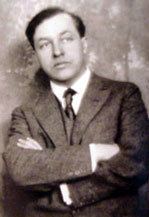Name William Purcell | Role Architect | |
 | ||
Died 1965, Pasadena, California, United States Books St. Croix Trail Country: Recollections of Wisconsin Structures Merchants National Bank People also search for George Grant Elmslie, William L. Steele, George Feick, Jr. | ||
William Gray Purcell (July 2, 1880 – April 11, 1965) was a Prairie School architect in the Midwestern United States. He partnered with George Grant Elmslie. The firm of Purcell & Elmslie produced designs for buildings in twenty two states, Australia, and China. The firm had offices in Minneapolis, Minnesota, Chicago, Illinois, Philadelphia, Pennsylvania, and Portland, Oregon.
Contents
Early life and education
Purcell was born in Wilmette, Illinois on July 2, 1880. His father was Charles A. Purcell, an important grain trader, and his grandfather, William Cunningham Gray, was a writer of national reputation. Purcell was raised by his grandparents in Oak Park, Illinois, near the home of Frank Lloyd Wright. He graduated from Cornell University with a degree in architecture in 1903.
Career
After graduation, Purcell worked for a few months for Henry Ives Cobb, and then for Louis Sullivan until the end of 1903. In 1904 he traveled to the West Coast to work for John G. Howard in Berkeley, California and for Charles H. Bebb and Leonard L. Mendell in Seattle, Washington.
The architectural practice most widely known as Purcell & Elmslie consisted of three partnerships. The first, Purcell & Feick, was formed in Minneapolis, in 1907 between Purcell and his Cornell classmate, George Feick, Jr. George Elmslie and Purcell had been friends since 1903, when Purcell worked for a short while in the office of Louis Sullivan, and Elmslie was an informal influence in the work of Purcell & Feick. In 1909, Elmslie joined the office in Minneapolis, and the name of the firm changed to Purcell, Feick, & Elmslie in 1910. Feick left the partnership in 1912, and the name of the practice became Purcell & Elmslie until being dissolved in 1921.
Over the course of the partnership, Purcell & Elmslie became one of the most commissioned firms among the Prairie School architects, second only to Frank Lloyd Wright. After his partnership with Elmslie ended, Purcell continued with his own practice in Portland, Oregon, before tuberculosis forced him into bedrest in a sanatorium at Banning, California, between 1931 and 1935. Following successful lung surgery, Purcell retired to an estate in the foothills of Southern California, near Pasadena. He continued to develop and support the cause of American architecture for another thirty years, mostly through publishing many essays, consulting with architectural historians, and other writing.
During 1962-1963, Purcell had an architectural apprentice who would go on to become a significant American organic architect, Arthur Dyson. Dyson spent nearly a year in the Taliesin Fellowship prior to the death of Frank Lloyd Wright in 1959, before going to work for notable organic architect Bruce Goff, who gave Dyson a copy of a catalog from an exhibition about Purcell and Elmslie that took place in Minneapolis. Dyson sought out Purcell as a mentor. The two men spent their time together reviewing the records of Purcell and Elmslie and discussing the nature of architectural design.
After his death on April 11, 1965, he was buried in the Forest Home Cemetery, Forest Park, Illinois.
Works
There are two houses built by William Gray Purcell for his personal residence in Minneapolis. The second was built in 1913 and called "Lake Place" by the Purcell family. Known now as the Edna S. Purcell House, the house is maintained by the Minneapolis Institute of Arts and is listed on the National Register of Historic Places. This residence is considered one of the finest achievements of any progressive firm in residential design.
His "Maryhill" in Edina, Minnesota, is interesting because of the documentation of how it was created. It was designed by Purcell in correspondence with the future owners, Paul and Mary Carson, and the 600 pieces of their correspondence are in the University of Minnesota's Architectural Archives.
Not all of Purcell's work fits in the "Prairie School" category. Several of his houses in Portland's West Hills show how he adapted his ideas to fit a more urban setting. A feature shared by one of those houses and Maryhill is a sleeping loft, but the Portland example also features a wooden carving of Nils on his goose flying out over the living room.
In the 1920s, Purcell moved to the Pacific Northwest where he designed a number of "cotswald" style homes.
In 1922, Purcell designed the Louis and Elizabeth Woerner House in the Alameda District of Portland’s Eastside. The house was added to the National Register of Historic Places (NRHP) in 2004.
In the 1930s Purcell moved to Pasadena, California. In Pasadena, Purcell first built Moderne work. His only known surviving Moderne building is his own vacation home in Palm Springs. Purcell after WW2 seems to have fully embraced modernism and some five homes designed by him from 1945-1965 survive in Pasadena in various levels of modification.
Achievements and publications
Purcell was elected a Fellow in the American Institute of Architects in 1963.
Purcell is the author of the 1967 book, St. Croix Trail Country: Recollections of Wisconsin, a memoir of his youth spent in the Wisconsin lake country.
